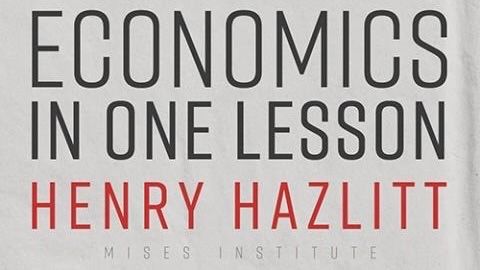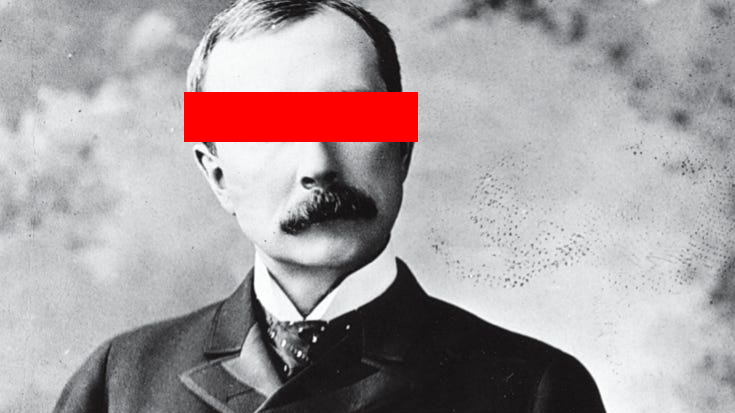Economics in One Lesson by Henry Hazlitt
Everything we get must in some way be paid for. The world is full of so-called economists who in turn are full of schemes for getting something for nothing. They tell us that government can spend without taxing at all; that it can continue to pile up debt without ever paying it off.

Empathy is bad politics because you only empathize with the people you can see (those who are closest to you, those that you see on TV, or a caricature that you have in your mind). Then you make a policy specifically for them but you ignore the other 100 groups of people that the policy impacts. In the end, the policy may not even work for its intended purpose and may have unforeseen second- or third-order consequences.
Part 1: The Lesson
Chapter 1
The Lesson
This is the persistent tendency of men to see only the immediate effects of a given policy, or its effects only on a special group, and to neglect to inquire what the long-run effects of that policy will be not only on that special group but on all groups. It is the fallacy of overlooking secondary consequences.
Economics in one sentence: The art of economics consists in looking not merely at the immediate but at the longer effects of any act or policy; it consists in tracing the consequences of that policy not merely for one group but for all groups.
Part 2: The Lesson Applied
Chapter IV
Public Works Means Taxes
Everything we get, outside of the free gifts of nature, must in some way be paid for. The world is full of so-called economists who in turn are full of schemes for getting something for nothing. They tell us that government can spend without taxing at all; that it can continue to pile up debt without ever paying it off, because “we owe it to ourselves.”
- Such peasant dreams in the past have always been shattered by national insolvency (unable to pay debts owned) or runaway inflation. Here we shall have to say simply that all government expenditures must eventually be paid out of the proceeds of taxation; that in elation itself is merely a form, and a particularly vicious form, of taxation.
A certain amount of public spending is necessary to perform essential government functions. A certain amount of public works - of streets and roads and bridges and tunnels, of armories and navy yards, of buildings to house legislatures, police, and fire departments - is necessary to supply essential public services.
For every dollar that is spent on public works, a dollar will be taken away from taxpayers. They will have that much taken away from them which they would otherwise have spent on the things they need most. Therefore, for every public job created by building a bridge, a private job has been destroyed somewhere else.
- $10 million spent to build a new bridge takes money from business owners who could take the same $10 million to hire employees and build bigger businesses that last longer than a 1 year bridge project.
- More bridge workers, but fewer automobile workers, television technicians, clothing workers, farmers, etc.
The two arguments for public housing: (1) It creates employment and (2) it creates wealth which would not otherwise have been produced, but;
- Taxation for public housing destroys as many jobs in other lines as it creates in housing.
- This results in unbuilt private homes, unmade washing machines and refrigerators, and in lack of innumerable other commodities and services.
- This outcome is not remedied by annual rent subsidies instead of a lump sum capital appropriation.
- This simply means that the cost to taxpayers is spread out over many years instead of being concentrated into one.
Providing jobs cannot be the main purpose of a public work
- Because then the more wasteful the work, the more costly in manpower, the better it becomes for the purpose of providing more employment
- Under such circumstances it is highly improbable that the projects thought up by the bureaucrats will provide the same net addition to wealth and welfare, per dollar expended, as would have been provided by the taxpayers themselves, if they had been provided by the taxpayers themselves, if they had been individually permitted to buy or have made what they themselves wanted, instead of being forced to surrender part of their earnings to the state.
- Because free market competition causes private businesses to refine and continually make their means of production more efficient.
Chapter V
Taxes Discourage Production
When a corporation loses a hundred cents of every dollar it loses, and is permitted to keep only 52 cents of every dollar it gains (because of taxes), and when it cannot adequately offset its years of losses against its years of gains, its policies are affected. It does not expand its operations, or it expands only those attended with a minimum of risk.
- In short, when businesses are heavily taxed, they cannot expand operations or hire more employees.
- People who recognize this situation are deterred from starting new enterprises. Thus old employers do not give more employment, or not as much more as they might have, and others decide not to become employers at all. Improved machinery and better-equipped factories come into existence much more slowly than they otherwise would. The result in the long run is that consumers are prevented from getting higher-quality and lower-cost products to the extent that they otherwise would, and that real wages are held down, compared with what they might have been.
There is a similar effect when personal incomes are taxed 50, 60, or 70 percent. People begin to ask themselves why they should work 6, 8 , or 9 months out of the year for the government, and only 6, 4, or 3 months for themselves and their families.
The larger percentage of the national income taken by taxes the greater the deterrent to private production and employment.
Chapter VI
Credit Diverts Production
All credit is debt. Proposals for an increased volume of credit, therefore, are merely another name for proposals for an increased burden of debt. They would seem considerably less inviting if they were habitually referred to by the second name instead of by the first.
There is a decisive difference between the loans supplied by private lenders and the loans supplied by a government agency. Each private lender risks his own funds (A banker, it is true, risks the funds of others that have been entrusted to him; but if money is lost he must either make good out of his own funds or be forced out of business.) When people risk their own funds, they are usually careful in their investigations to determine the adequacy of the assets pledged and the business acumen and honesty of the borrower. The whole point of the government giving loans is that they give them to people who could not get them from private lenders.
- People look for and get loans to be a more productive member of society. If they fail and can’t repay the loan, it is bad for the lender and society because there is no increase in output by the debtor.
- People selected for government loans will be poorer selects than those selected by private lenders because private lenders have higher standards.
- The debtors will be less efficient. More resources will be wasted by them.
- The net result of government credit has not been to increase the amount of wealth produced by the community but to reduce it, because the available real capital (consisting of actual farms, tractors, etc.) has been placed in the hands of the less efficient borrowers rather than in the hands of the more efficient and trustworthy.
In short, government loans, when compared to private loans, will reduce production, not increase it.
The government cannot give credit to businesses that it does not first or finally take from business. (Because the government only gets capital from taxes that it takes from businesses.)
- By giving credit and saving one business, you cause another business to fail or not be founded. There is an opportunity cost to the capital that the government gives out to poor debtors.
Chapter VII
The Curse of Machinery
Some people argue against using labor-saving machines because it reduces the demand for labor and therefore laborers will lose their jobs.
- The logical conclusion from this would be that the way to maximize jobs is to make all labor as inefficient and unproductive as possible.
Why more technology doesn’t necessarily mean higher unemployment:
- The machine or technology itself requires someone to make it; so here, as one offset, are jobs that would not otherwise have existed.
- The CEO will then make more profit in the long run once the machines pay for themselves, because the machines would only be adopted if they made either better suits for half as much labor, or had made the same kind of suits at a smaller cost.
- With the extra money he will do any combination of 3 things and they all increase employment in a different way (assuming he does not hoard the money)
- He will use the extra profits to expand his operations by buying more machines to make more product
- He will invest the profits in some other industry
- He will spend the extra profits on increasing his own consumption
- Increased technology lowers the cost of production over time. Over time, the savings will be passed along to the consumers. Increasing the consumers’ purchasing power
- Consumers will then spend the money they “saved” by the decreased price somewhere else, creating more jobs in that other industry
- If the demand is elastic (a fall in price causes a larger total amount of money to be spent on the product) then more people may be employed after the technology than before. This happened with stockings and other textiles.
Chapter IX
The Fetish of Full Employment
Production is the end, employment is merely the means. We cannot continuously have the fullest production without full employment. But we can very easily have full employment without full production.
Chapter XI
Who’s “Protected” by Tariffs?
The sweater manufacturer example: There is a sweater manufacturer in America who sells sweaters for $30. The same sweater made in Europe costs $25 in America. America would have to create a tariff of $5 to keep the American manufacturer in business and keep its 1000 employees employed.
Saving a business by placing tariffs on the European sweater reduces the amount of purchasing power for every sweater consumer. Each consumer would have an extra $5 if they could buy the European sweater for $25. This $5 can be spent elsewhere and create more jobs in other businesses.
- The Europeans are also eventually forced to buy more from America if their dollar balances are not to remain perpetually unused. So as a result of letting in British goods, we must export more American goods.
Labor in each country is more fully employed in doing just those things that it does best, instead of being forced to do things that it does inefficiently or badly. Consumers in both countries are better off. They are able to buy what they want where they can get it cheapest. American consumers are better provided with sweaters, and British consumers are better provided with washing machines and aircraft.
If you want to increase the number of American businesses and American jobs by placing a tariff on foreign goods, that one American industry would grow at the expense of 100 other industries that could have naturally grown in the market. If 50,000 people are now employed by that one industry created by tariffs, then 50,000 fewer people are employed elsewhere in other industries.
- People think that creating a new American industry based on tariffs is good because the industry is clearly visible. You can see the physical buildings. You can count the number of employees working in the new industry. You can see the capital invested and the market value of its product in terms of dollars. The results would be palpable and direct.
- But the shrinkage of a hundred other industries, the loss of 50,000 other jobs somewhere else would not be easily noticed. It would be impossible for even the cleverest statistician to know precisely what the incidence of the loss of their jobs had been — Precisely how many men and women had been laid off from each particular industry, precisely how much business each particular industry had lost — because consumers had to pay more for their sweaters (or item that the tariffed industry produced). A loss for the other productive activities of the country would be comparatively minute for each. It would be impossible for anyone to know precisely how each consumer would have spent his extra $5 if he had been allowed to retain it. The overwhelming majority of the people, therefore, would probably suffer from the illusion that the new industry has cost us nothing.
Tariffs reduce American wages. There would be no net increase in the number of jobs provided, no net increase in demand for goods, and no increase in labor productivity. Labor productivity would be reduced as a result of the tariff.
Chapter XII
The Drive for Exports
In the long run, imports and exports must equal each other. The greater exports we have, the greater imports we must have, if we ever expect to get paid.
An American exporter sells his goods to a British importer and is paid in British pounds sterling. But he cannot use British pounds to pay the wages of his workers, to buy his wife’s clothes, or to buy theater tickets. For all these purposes he needs American dollars. Therefore his British pounds are of no use to him unless he either uses them himself to buy British goods or sells them (through his bank or another agent) to an American importer who wishes to use them to buy British goods. Whichever he does, the transaction cannot be completed until the American exports have been paid for by an equal amount of imports.
A gold standard (or a Bitcoin standard) would make the import/export process easier because all of the countries on the gold standard would accept gold instead of having to trade.
Giving loans to foreign nations that will not be repaid does not increase US exports. If the loans given to foreign countries to enable them to buy our goods are not repaid, then we are giving away the goods for free. A nation cannot grow rich by giving goods away. It can only make itself poorer.
In the long run, business and employment in America would be hurt, not helped, by foreign loans that were not repaid. For every extra dollar that foreign buyers had with which to buy American goods, domestic buyers would ultimately have one dollar less. Businesses that depend on domestic trade would therefore be hurt in the long run as much as export businesses would be helped.
- The unpaid loans can even hurt the export businesses. American automobile companies sold about 15% of their output in the foreign market in 1975. It would not profit them to sell 20% of their output abroad as a result of bad foreign loans if they thereby lost, say 10% of their American sales as the result of added taxes taken from American buyers to make up for the unpaid foreign loans.
- Loans are not inherently bad, they just need to be given to people with a high probability of paying them back.
An export subsidy is inherently bad. It entails selling goods for less than it costs to make them.
Chapter XV
How the Price System Works
The “marginal” producers are less efficient (costs of production are the highest) and will be driven out of business when demand for their product falls.
Prices are determined by supply and demand.
Demand is determined by how intensely people want a commodity and what they have to offer in exchange for it.
Supply is in part determined by costs of production.
If the demand falls off for some product, its price and the profit in making it go lower, and its production declines.
It is only the much vilified price system that solves the enormously complicated problem of deciding precisely how much of tens of thousands of different commodities and services should be produced in relation to each other. These otherwise bewildering equations are solved quasi-automatically by the system of prices, profits, and costs. They are solved by this system incomparably better than any group of bureaucrats could save them.
- It allows consumers to choose what they actually want rather than having bureaucrats decide what is good for them.



Comments ()